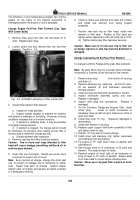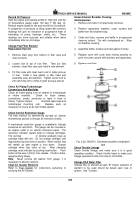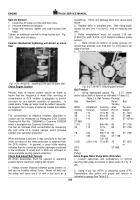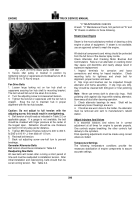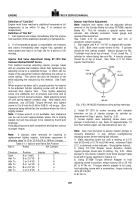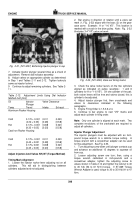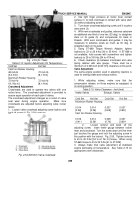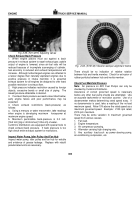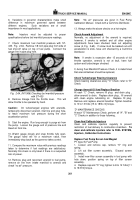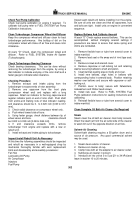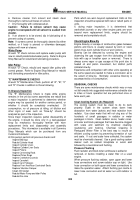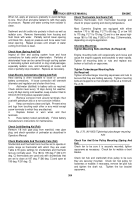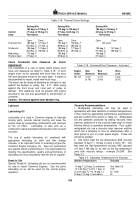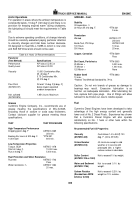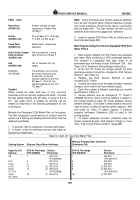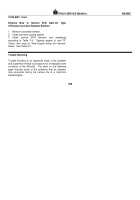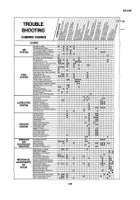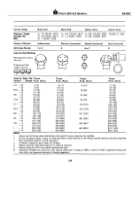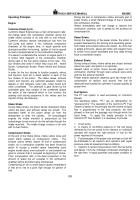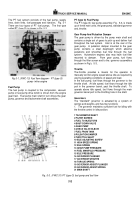TM-5-3805-254-14-P-2 - Page 307 of 894
TRUCK SERVICE MANUAL
ENGINE
6.
Remove cleaner from solvent and steam clean
thoroughly to remove all traces of solvent.
7.
Dry thoroughly with compressed air.
Caution:
Failure to remove solvent may cause
engine to overspeed until all solvent is sucked from
cleaner.
8.
If air cleaner is to be stored, dip in lubricating oil to
prevent rusting of screens.
Note:
If screens cannot be thoroughly cleaned by either
method, or if body is pierced or otherwise damaged,
replace with new air cleaner.
Water Pump
At each "D" check remove and replace water pump with
new or rebuilt prelubricated water pump.
Refer to Engine
Shop Manual for rebuild and lubricating procedure.
Idler Pulley
At each "D" Check, rebuild and repack idler pulley with
correct grease.
Refer to Engine Shop Manual for rebuild
and lubricating procedure for idler pulley.
"E" MAINTENANCE CHECKS
At each "E" Maintenance Check, perform all "A", "B", "C"
and "D" Checks in addition to those following.
In Chassis Inspection
The "E" Maintenance Check is made while engine
remains in the unit but some assemblies are rebuilt and
a major inspection is performed to determine whether
engine may be operated for another service period, or
whether it should be completely overhauled.
Oil
consumption, no oil pressure at idling, oil dilution and
other signs of wear such as "blow-by" should be
analyzed as part of the inspection.
Since major inspection requires partial disassembly of
the engine, it should be done only in a well-equipped
shop by mechanics thoroughly familiar with worn
replacement limits and disassembly and assembly
procedures.
This information is available in all Cummins
Shop Manuals which can be purchased from any
Cummins Distributor.
At this period, perform all previous checks and:
Inspect Bearings
Rebuild Cylinder Head
Inspect Cylinder Liners
Replace Cylinder Liner Seals
Inspect Pistons
Inspect Connecting Rods
Replace Piston Rings
Inspect Crankshaft Journals
Inspect Camshaft
Inspect Cam Followers
Replace Front And Rear Crankshaft Seals
Replace Vibration Damper
Clean Oil Cooler
Rebuild Water Pump and Idler Pulley
Rebuild Fan Hub
Parts which are worn beyond replacement limits at this
inspection should be replaced with new or rebuilt parts or
units.
If, during major inspection, it is determined that
crankshaft journals or any other engine parts are worn
beyond worn replacement limits, engine should be
removed and completely rebuilt.
Check Engine Blow-By
Engine blow-by or escape of combustion gases between
pistons and liners, is usually caused by worn or stuck
piston rings, worn cylinder liners or worn pistons.
Blow-by can be detected by running the engine and
observing the gas escape from the lubricating oil filler
hole with cap or breather open or removed.
There is
always some vapor or gas escape at this point due to
heated oil and piston movement, but distinct puffs
indicate blow-by.
Experience and comparison with other units operating at
the same speed are-needed to make a conclusion as to
the extent of blow-by.
Normally, excessive blow-by is
accompanied by oil consumption.
SEASONAL CHECKS
There are some maintenance checks which may or may
not fall exactly into suggested maintenance schedule due
to miles or hours operation but are performed once or
twice each year.
Clean Cooling System (As Required)
The cooling system must be clean to do its work
properly. Scale in the system slows down heat
absorption from water jackets and heat rejection from
radiator.
Use clean water that will not clog any of the
hundreds of small passages in radiator or water
passages in block.
Clean radiator cores, heater cores,
oil cooler and block passages that have become clogged
with scale and sediment by chemical cleaning,
neutralizing
and
flushing.
Chemical
Cleaning
A
Fleetguard Water Filter is the best way to insure an
efficient cooling system by preventing formation of rust
and scale.
If rust and scale have collected, the system
must be chemically cleaned.
Use a good cooling system
cleaner such as sodium bisulphate or oxalic acid
followed by a neutralizer and flushing.
Pressure Flushing
Flush radiator and block when antifreeze is added or
removed, or before installing a water filter on a used
engine.
When pressure flushing radiator, open upper and lower
hose connections and screw radiator cap on tight.
Use
hose connection on both upper and lower connections to
make the operation easier.
Attach flushing gun nozzle to
lower hose connection and let water run until radiator is
full.
303
Back to Top

